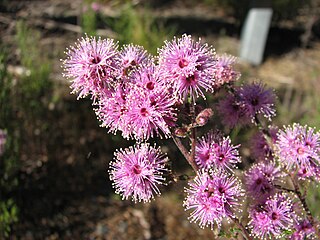
Kunzea parvifolia, commonly known as the violet kunzea, is a flowering plant in the myrtle family, Myrtaceae and is endemic to eastern Australia. It is a wiry shrub with small, narrow leaves and clusters of pink to purple flowers in spring.

Kunzea montana, commonly known as mountain kunzea, is a flowering plant in the myrtle family, Myrtaceae and is endemic to the south-west of Western Australia. It is a shrub or small tree with more or less round leaves and heads of cream-coloured to pale yellow flowers on the ends of the branches in late spring. It is an uncommon species, growing on rocky mountain slopes, but all populations are conserved in the Stirling Range National Park.
Kunzea acicularis is a flowering plant in the myrtle family, Myrtaceae and is endemic to the south-west of Western Australia. It is a shrub with a few erect stems, small and groups of three to five, pink to mauve flowers. It is a rare, recently described species only known from a small area near Ravensthorpe.
Kunzea acuminata is a flowering plant in the myrtle family, Myrtaceae and is endemic to the south-west of Western Australia where it has a restricted distribution. It is a shrub with a few spindly branches, silky leaves and spherical groups of pink flowers on the ends of the branches.
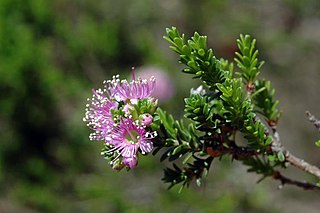
Kunzea ciliata is a flowering plant in the myrtle family, Myrtaceae and is endemic to the south-west of Western Australia. It is a spreading shrub which typically grows to a height of 0.8 to 1.5 metres and blooms between October and November producing pink flowers.
Kunzea cincinnata is a flowering plant in the myrtle family, Myrtaceae and is endemic to a small area on the south coast of Western Australia. It is a shrub which typically grows to a height of 0.6 to 1 metre and blooms between September and October producing pink to red-purple flowers.

Kunzea clavata, commonly known as the Torbay spearwood, is a flowering plant in the myrtle family, Myrtaceae and is endemic to a small area on the south coast of Western Australia. It is a shrub or tree, typically with many branches and grows to a height of 2.5 to 4 metres. It blooms between September and October producing yellow flowers.

Kunzea micromera is a flowering plant in the myrtle family, Myrtaceae and is endemic to the south west of Western Australia. It is a small, sparse shrub, similar in some respects to K. micrantha but has shorter, more rounded sepal lobes. It produces groups of pink flowers on the ends of a few long shoots in spring.

Kunzea newbeyi is a flowering plant in the myrtle family, Myrtaceae and is endemic to a small area along the south coast of Western Australia. It is a robust shrub with small leaves and groups of about twenty to thirty pink flowers in October and November.
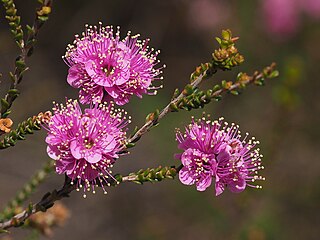
Kunzea rostrata is a species of flowering plant in the myrtle family, Myrtaceae and is endemic to an area along the south west coast of Western Australia. It is a shrub with small, mostly elliptic leaves and with groups of between mostly eleven and fifteen rose pink flowers mainly on the ends of branches that continue to grow after flowering.

Kunzea similis is a species of flowering plant in the myrtle family, Myrtaceae and is endemic to a small area along the south coast of Western Australia. It is a shrub with linear to lance-shaped leaves with a single vein, and spherical groups of between four and ten pink flowers on the ends of shoots.
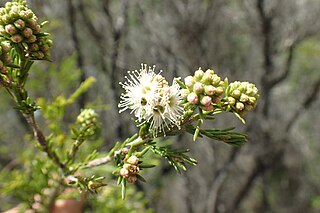
Kunzea spathulata is a species of flowering plant in the myrtle family, Myrtaceae and is endemic to a small area in the south west of Western Australia. It is a tall shrub with erect, much-branched stems, linear leaves and more or less spherical groups of yellow or yellowish green flowers.
Kunzea aristulata is a flowering plant in the myrtle family, Myrtaceae and is endemic to a small area of New South Wales. It is an erect, spreading shrub similar to Kunzea rupestris but is distinguished from it mainly by the shape of its leaves. It is only known from a remote area north of Yerranderie where it often grows on cliff edges.
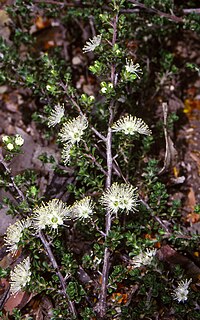
Kunzea badjaensis is a flowering plant in the myrtle family, Myrtaceae and is endemic to a small area of New South Wales. It is a shrub with egg-shaped leaves and clusters of white flowers near the end of the branches. It grows at high altitudes on the Southern Tablelands.
Kunzea caduca is a plant in the myrtle family, Myrtaceae and is endemic to Queensland. It is a spreading shrub with linear to lance-shaped leaves and groups of white to cream-coloured flowers on the ends of all the branches from late winter to early spring. It is only known from a few locations and only conserved in the Castle Tower National Park near Gladstone.
Kunzea dactylota is a flowering plant in the myrtle family, Myrtaceae and is endemic to a small area of New South Wales. It is a spreading shrub with small, finger-shaped leaves and clusters of white flowers near the end of the branches. It grows at high altitudes on the Southern Tablelands of the state.
Kunzea juniperoides is a flowering plant in the myrtle family, Myrtaceae and is endemic to a small area of New South Wales. It is a small shrub with narrow leaves and small groups of white flowers near the end of the longer branches. It is distinguished from similar kunzeas by the large number of scale-like perules and bracts surrounding the groups of flowers.

Kunzea occidentalis is a flowering plant in the myrtle family, Myrtaceae and is endemic to a western New South Wales. It is a shrub with narrow leaves and small groups of white flowers on leafy side-branches. It is distinguished from the similar Kunzea ambigua by the flanges on the sides of its young branches.
Kunzea petrophila is a flowering plant in the myrtle family, Myrtaceae and is endemic to the Northern Territory. It is a spreading shrub with hairy branches and leaves, narrow leaves and cream-coloured flowers in more or less spherical groups usually on the ends of the main branches.
Kunzea sericothrix is a plant in the myrtle family, Myrtaceae and is endemic to Queensland. It is a small shrub with linear to lance-shaped leaves. It is only known from a single collection, and the details of its flowers are provisional.










